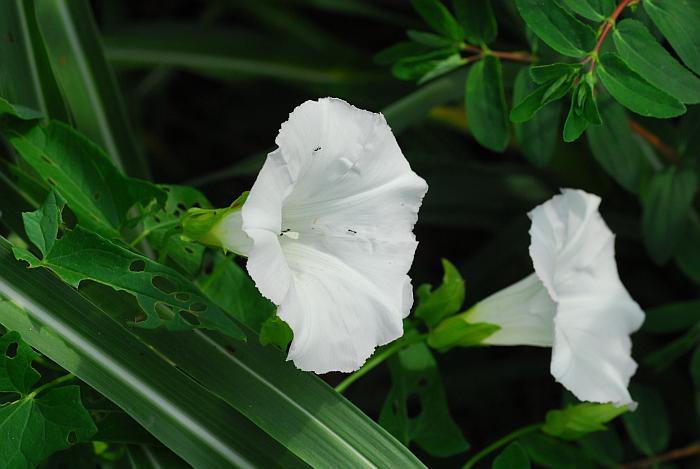Calystegia sepium (L.) R. Br.
Hedge Bindweed

Native
CC = 1
CW = 0
MOC = 54
© SRTurner
Calystegia sepium (L.) R. Br.Hedge Bindweed | |
 |
Native CC = 1 CW = 0 MOC = 54 |
© SRTurner |
|
Family - Convolvulaceae Habit - Rhizomatous perennial forb, twining on other vegetation. Stems - Twining and climbing on other vegetation, to 3 m, glabrous or nearly so.
Leaves - Alternate, long petiolate, glabrous. Petioles longer than half the length of the blade midveins. Blades to 9 cm, narrowly ovate-triangular, usually sharply pointed at tip, deeply cordate at base, the basal sinus U-shaped or V-shaped (opposing sides divergent), the 2 basal lobes often each with 1 or 2 additional shallow lobes along the upper portion, frequently somewhat spreading, angular, bluntly to sharply pointed. Blades otherwise entire.
Inflorescences - Flowers solitary or less commonly paired in the axils of leaves. Bracts 14-25 mm long, usually overlapping only toward the base, not strongly inflated (usually appearing somewhat angular), ovate to triangular-ovate, bluntly to more commonly sharply pointed at the tip, glabrous or sparsely hairy along the margins.
Flowers - Actinomorphic, hypogynous, perfect. Sepals 11-15 mm long, free, elliptic to narrowly ovate. Corollas very shallowly 5-lobed, 4-7 cm long, funnelform, white, sometimes pink tinged. Stamens 5, alternating with corolla lobes, not exserted. Pistil 1 per flower, of 2 fused carpels. Ovary superior, 2-locular, usually appearing 1-locular toward the tip, with 4 ovules. Style 1, the stigmas 2, oblong to ovate in outline, somewhat flattened.
Fruits - Capsules, globose to ovoid, 10-15 mm long, 1-locular, dehiscing longitudinally, the wall separating into 4 segments. Seeds 1-4, 4-5 mm long, oblong-ovate to ovate in outline, somewhat longitudinally angled on the inner face, the surface smooth to very finely granular, dark brown to more commonly black, glabrous. Flowering - May - September. Habitat - Hedgerows, forest borders, streambanks, pond margins, fields, pastures. Origin - Native to the U.S. Lookalikes - Calystegia silvatica; more broadly, several other members of the Calystegia and Convolvulus genera. Other info. - This is a common plant throughout most of Missouri, and also across most of the continental U.S. It is most easily found in the mornings, as the large white flowers tend to close up in the afternoon. This species appears very similar to the closely related C. silvatica. Characters to note include the basal leaf sinus (the recess surrounding the petiole attachment), which in this species has divergent and not parallel sides. Also, the leafy bracts subtending the flower are usually pointed, and usually overlap only near the base and sometimes not at all. See photos above. That said, the taxonomy of this group is controversial, and some authors subdivide the genus differently, or do not distinguish this species from C. silvatica. Field experience quickly teaches that the above characters do not always correlate well. In some cases this difficulty may be due to hybridization with C. silvatica, which is known to occur. Photographs taken at Weldon Spring Conservation Area, St. Charles County, MO, 7-12-2010, along the Katy Trail near Dutzow, Warren County, MO,8-2-2012, and Riverlands Migratory Bird Sanctuary, St. Charles County, MO, 7-16-2015 (SRTurner). |